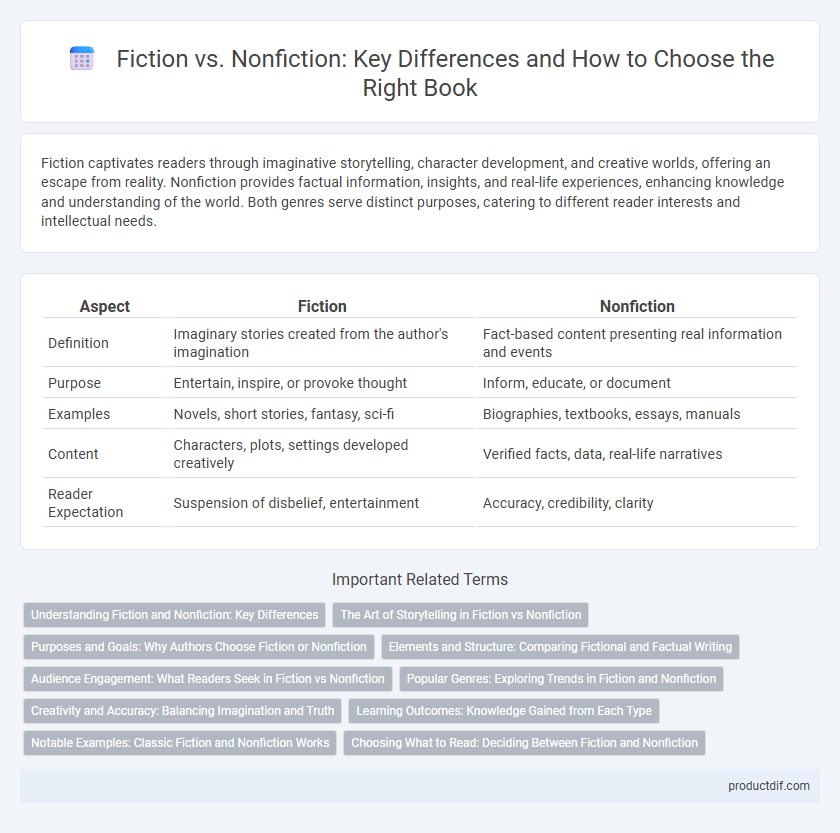Fiction captivates readers through imaginative storytelling, character development, and creative worlds, offering an escape from reality. Nonfiction provides factual information, insights, and real-life experiences, enhancing knowledge and understanding of the world. Both genres serve distinct purposes, catering to different reader interests and intellectual needs.
Table of Comparison
| Aspect | Fiction | Nonfiction |
|---|---|---|
| Definition | Imaginary stories created from the author's imagination | Fact-based content presenting real information and events |
| Purpose | Entertain, inspire, or provoke thought | Inform, educate, or document |
| Examples | Novels, short stories, fantasy, sci-fi | Biographies, textbooks, essays, manuals |
| Content | Characters, plots, settings developed creatively | Verified facts, data, real-life narratives |
| Reader Expectation | Suspension of disbelief, entertainment | Accuracy, credibility, clarity |
Understanding Fiction and Nonfiction: Key Differences
Fiction presents imaginative narratives created from the author's creativity, often exploring themes through characters and plots that may not exist in reality. Nonfiction, grounded in factual information, aims to inform or explain real-world subjects such as history, science, or biography with accuracy and evidence-based content. Understanding these distinctions helps readers select books based on their preference for creativity or factual learning.
The Art of Storytelling in Fiction vs Nonfiction
The art of storytelling in fiction utilizes imaginative narratives, character development, and plot twists to engage readers on an emotional level, creating immersive worlds that explore human experiences. Nonfiction storytelling relies on factual accuracy, structured information, and real-world examples to inform and persuade, often incorporating personal anecdotes or case studies to enhance credibility and relatability. Both genres leverage narrative techniques, but fiction prioritizes creativity and emotional resonance while nonfiction emphasizes evidence-based communication and clarity.
Purposes and Goals: Why Authors Choose Fiction or Nonfiction
Authors choose fiction to explore imaginative worlds, convey complex emotions, and provoke critical thinking through storytelling, often aiming to entertain, inspire, or challenge readers' perspectives. Nonfiction writers prioritize delivering factual information, educating the audience, and providing real-life insights or solutions, catering to readers seeking knowledge, truth, or practical guidance. The purpose in fiction centers on evoking empathy and creativity, while nonfiction focuses on credibility and clarity to inform or persuade.
Elements and Structure: Comparing Fictional and Factual Writing
Fictional writing employs imaginative elements like character development, plot arcs, and thematic motifs to create immersive narratives, often structured with rising action, climax, and resolution. Nonfiction writing prioritizes factual accuracy, logical organization, and evidence-based content, using structures such as chronological order, cause and effect, or problem-solution formats to inform or persuade readers. The contrasting elements and structures between fiction and nonfiction serve different purposes: evoking emotional engagement versus delivering clear, reliable information.
Audience Engagement: What Readers Seek in Fiction vs Nonfiction
Readers seek immersive experiences and emotional connections in fiction, craving well-developed characters and imaginative plots that evoke empathy and escapism. In nonfiction, audiences prioritize factual accuracy, clear explanations, and practical insights that satisfy curiosity and enhance knowledge. Engagement in nonfiction hinges on credibility and relevance, while fiction captivates through storytelling and emotional resonance.
Popular Genres: Exploring Trends in Fiction and Nonfiction
Popular fiction genres such as thrillers, fantasy, and romance consistently dominate bestseller lists, driven by readers seeking escapism and emotional engagement. Nonfiction trends highlight memoirs, self-help, and true crime, reflecting a growing appetite for personal growth and real-world stories. Both categories show strong digital and audiobook formats, catering to evolving consumer preferences and expanding accessibility.
Creativity and Accuracy: Balancing Imagination and Truth
Fiction ignites creativity by weaving imaginative narratives that explore possibilities beyond reality, offering readers emotional and intellectual engagement. Nonfiction prioritizes accuracy, delivering factual information and real-world insights that build knowledge and trust. Balancing imagination and truth in books enriches readers' experiences, blending creative storytelling with credible content to inspire and inform simultaneously.
Learning Outcomes: Knowledge Gained from Each Type
Fiction immerses readers in imaginative worlds that enhance empathy, creativity, and critical thinking by presenting complex characters and scenarios. Nonfiction delivers factual information, enabling readers to acquire specific knowledge, develop objective understanding, and improve analytical skills. Combining both genres maximizes learning outcomes by balancing emotional engagement with evidence-based insights.
Notable Examples: Classic Fiction and Nonfiction Works
Classic fiction works like "Pride and Prejudice" by Jane Austen and "1984" by George Orwell explore complex human emotions and societal issues through imaginative storytelling. Notable nonfiction titles such as Malcolm Gladwell's "Outliers" and Michelle Obama's "Becoming" provide insightful analysis and personal narratives grounded in real-world experiences. Both genres offer enduring contributions to literature, enriching readers' understanding of diverse perspectives and knowledge.
Choosing What to Read: Deciding Between Fiction and Nonfiction
Choosing between fiction and nonfiction involves considering your purpose for reading: fiction often enhances creativity and empathy through storytelling, while nonfiction provides factual knowledge and real-world insights. Readers seeking escapism or emotional connection may prefer fiction, whereas those aiming for learning and critical thinking may lean toward nonfiction. Evaluating interests, goals, and the desired reading outcome helps in making an informed choice between fiction and nonfiction books.
Fiction vs Nonfiction Infographic

 productdif.com
productdif.com